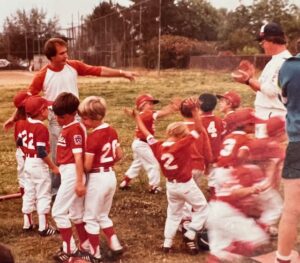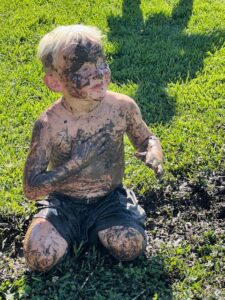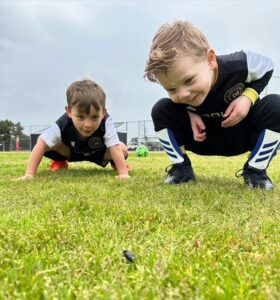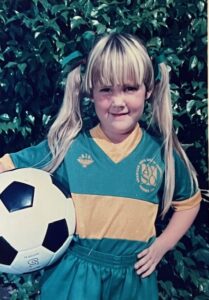The Green Meanies
 Opening Day, 1981 T‑ball season. Yankees v. Red Sox. Top of the first inning.
Opening Day, 1981 T‑ball season. Yankees v. Red Sox. Top of the first inning.
Bob, the Yankees tall gangly head coach, knelt beside his lead-off hitter and son, Stevie, a wiry little kid with sandy hair and two missing upper front teeth. Bob placed the ball on the tee and guided Stevie into a batting stance, feet spread apart, back elbow up, front elbow down.
In the field, Arnold, the Red Sox head coach, a short musclebound former college wrestler, stood on the pitcher’s mound behind his son, Arlo, a freckle-faced redhead with two missing bottom front teeth. Since the batter hits the ball off a tee in T‑ball, the “pitcher” doesn’t pitch, but he is the most important fielder because most “hits” trickle off the tee into the infield a few feet beyond home plate. The pitcher’s job is to rush in, grab the ball, and throw it to first base.
 “Fielder’s crouch,” Arnold said to Arlo. Arlo bent his knees and pounded his fist into his glove.
“Fielder’s crouch,” Arnold said to Arlo. Arlo bent his knees and pounded his fist into his glove.
At the tee Bob stepped back from Stevie. “Give it a level swing.”
Stevie launched a mighty twirl. Thunk! The bat struck the tee a foot below the ball. Nearly decapitated, the tee fell over like a dead soldier and spilled the ball into foul territory. Bob hopped forward, collected the ball, and reset the tee. “This time keep your eye on the ball all the way through the swing.”
Stevie’s second windmill grazed the top of the ball and flipped it off the tee to dribble five feet down the third base line where it rolled to a stop.
Both Arlo and Stevie froze, staring blankly at the dead ball.
“Go!” Arnold shouted, shoving Arlo. Arlo stumbled forward, then charged the ball.
“Run!” Bob screamed at the top of his lungs. Stevie flinched, panicked, and took off toward third base.
Arlo scooped up the ball and wheeled toward third.
 The third baseman, Robby, a drifty towheaded kid, stood on third base at parade rest, grinning vapidly at a pigeon flying over right field.
The third baseman, Robby, a drifty towheaded kid, stood on third base at parade rest, grinning vapidly at a pigeon flying over right field.
Arlo hurled the ball at Robby.
From the bleachers Robby’s mom bellowed, “Robby! Get in the game!”
Startled, Robby snapped to attention and spotted Arlo’s fastball zooming directly toward his face just in time to raise his glove instinctively in self-defense. Pop!
Barreling up the third base line like his life depended on it, Stevie ran through the bag at the same instant the ball hit Robby’s glove.
“Out!” Arlo yelled, pumping his fist in the air.
“Was not!” Stevie cried. “Safe by a mile!”
“Great catch, Robby!” Robby’s mom yelled.
Dazed, Robby stared at his glove, wondering how the ball got there.
Coach Bob wandered out to the mound and joined Coach Arnold. “What just happened?” Bob said.
“Your kid ran to third instead of first,” Arnold said. “My kid fielded the ball and threw him out.”
“Actually, Stevie beat the throw.”
“You kidding me? It doesn’t matter if he beat the throw. He’s automatically out. He ran to third instead of first. He played the game backwards.”
“Your kid did, too,” Bob said defensively.
Arnold looked at Arlo and Robby and sighed. “Yeah, they did everything right except for the backwards part. How the hell we gonna explain this to them?”
“It’s too complicated,” Bob said. “Let’s start over. I’ll make Stevie run to first this time.”
“Deal,” Arnold said.

In 1981, Bob was my barber. During a haircut in his shop in the LA Bonaventure Hotel, I told him I’d signed up to coach my son’s T‑ball team. He emitted a low whistle. “Toughest job I ever had.” He told me the Yankees-Red Sox opening day story. “Too many rules and not enough action,” he said. “I almost went crazy.”
Bob was right. Even with five dads helping me, we couldn’t keep the Phillies on track. During drills kids wrestled each other, wandered off aimlessly, or sprawled in the grass and gazed at the clouds. Only constant vigilance prevented players from practice-swinging their metal bats within range of another player’s head. The sudden appearance of a flying grasshopper would bring a game to a complete halt, and if there was a patch of mud anywhere on the field, the players always found it before the coaches did.

I didn’t go totally crazy, though, and I got to spend a lot of time with my son, so I volunteered to coach K‑division soccer in the fall. Like T‑ball, a mud puddle or a stink bug could stop a game cold, but otherwise coaching soccer was a lot easier. Not as many rules, and no dead time. You throw the ball on the ground. The kids mob it and scrum up and down the field with no idea what they’re doing. If the ball coincidentally rolls into the goal during a game, the parents and kids go wild.
I coached my kids’ teams for several years after that. All their teams were good, but the best team relative to its level I ever coached was my daughter Devon’s 1986 K‑division soccer team, the Green Meanies.

The first day of practice, I asked the kids what name they wanted to give the team. This is not always a good idea. The Bloody Maggots, for example, but this time it worked out well. Our uniforms were green. Devon said green rhymed with mean, and that sparked the name. The team Mom, Cindy, made a dark green team banner centered with the big round head of a blond-haired kid, his face contorted, his teeth bared.
The name and banner soon became infamous within the K‑division. Youth sports leagues strive to achieve balance among competing teams by using skill ratings to select rosters of approximately even talent, but five-year-olds have no track record, so placement in the K‑division is random. Random placement usually works out okay at that age anyway, but that was not the case with the Meanies.
That team was loaded. Five of them, including Devon, would grow up to become high school soccer all-stars, and even the lesser talents on the team were good little athletes. Most of them had been playing soccer in their backyards since they were toddlers. In the first practice, they passed the ball, dribbled with control, and shot accurately with both feet. I didn’t have to teach them anything.

In the season opener, they faced the Red Dragons. Jordan scored a goal for the Meanies on the kick-off. Thirty seconds later, Chris scored. Then Marcus hurled the ball into the goal from mid-field on an out-of-bounds throw-in. Devon scored. Jordan again. Then Taylor. Robby. Chris again.
Green Meanies 8 – Red Dragons 0. And that was only the first quarter.
The rules of the K‑division are designed to make every kid feel like a winner. There are no goalies to make it easier to score. Coaches roam the field to provide instruction and praise. There is no score board, and no one keeps score. Except, of course, the parents, who have neon scoreboards inside their heads.
During the first quarter break, the Dragons’ coach jumped me. “Back off, man! You’re running up the score!”
“I didn’t mean to run it up, ” I sputtered. “It all happened so fast.”
He rolled his eyes.
Ok, sportsmanship first, I thought. I held three of the superstars back near our goal to start the second quarter. The other two superstars promptly scored. I pulled them back, too, whereupon Marcus power-kicked a goal the entire length of the field. “Don’t aim for the goal,” I told the phenoms. “Just pass the ball to the Meanies up front.” On an average team the Meanies up front might have gone the whole season without scoring a goal, but with perfect passes from the back field, each scored multiple goals in that first game. Near the end of the third quarter, my internal neon scoreboard blew a fuse. Somewhere around goal 20 I lost count. Meanwhile, with the five superstars playing back, the Dragons couldn’t advance the ball past midfield. They goose-egged the game.
That first game set the tone for the Meanies’ season. They mowed down every team they faced, scoring more than ten goals in every game while never giving up a single opposing goal, and that was with me doing everything I could to hold them down.

At the end of the season, I didn’t have to make up positive stuff in my speeches when I presented them with trophies. I couldn’t praise them enough. They were all great players and great kids.
The Green Meanies ruled the K‑division forty years ago. They’re all grown now, and I don’t know where they are or what became of them.
Except for one Meanie.
Half-time, last game of the South Pasadena K‑division 2024 season. I stood beside Logan, grandson number two and star of the Teal Raptors. He drained his water bottle and looked up at me. “We never lose,” he said in a purposefully deep voice with a gravely serious expression on his face.
“You ever hear of the Green Meanies,” I asked him.
He nodded. “Mom told me.”
“They were really good,” I said.
“We’re really good, too,” he said.
Logan ran back on the field and scored two goals in the second half.

No one keeps score in the K‑division, but I happen to know the mighty Teal Raptors won that game and every game they played that season. This should be no surprise to anyone. After all, the Raptors were merely upholding a winning tradition handed down to them from the previous generation. Coach Devon, you see, was a proud Green Meanie.



April 21, 2025 @ 8:12 am
Ken, this is great. Youth sports can have such good impact on our children. Our little guy plays some soccer, but it is not always easy to stay focused next to the playground. Just like dad, he is happiest in the water. 🙂
April 24, 2025 @ 1:21 pm
Thanks for reading my blog, Zoli. It was fun to write. Brought back great memories for me. Treasure these years with your little guy. They are the best of times. Hope all is weel for you and family in Charlottesville.
April 13, 2025 @ 10:18 am
Trying to keep very young kids focused in the T‑Ball games is like herding cats, probably worse. I assisted in such games played by my kids and grandkids over the years and it’s always been quite interesting, to say the least. Only problems that arose were some parents took the games too seriously and made it rough on the players and other parents.
April 14, 2025 @ 7:08 am
If there is a way to keep the kids focused on T‑ball, I never figured it out. Soccer was so much easier, but I enjoyed all the sports I coached. Although parents of kids on some opposing teams caused problems, I was blessed over the years with supportive, reasonable parents. Coaching youth sports was a positive experience all the way around for me, great fun and a reason to spend quality time with my kids.
March 28, 2025 @ 11:48 am
Great story. Reminded me of my son’s soccer years. He only played in elementary school but loved it and so did I.
March 28, 2025 @ 11:57 am
Thanks, Alice. It’s a great game for coaching little kids. I had so much fun.